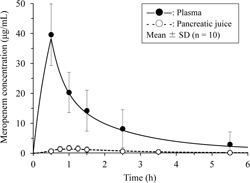|
Back to 2014 Annual Meeting Posters
Pancreatic Penetration of Meropenem and Dosage Considerations Based on Site-Specific Pharmacokinetic-Pharmacodynamic Analysis
Naru Kondo*1, Kazuro Ikawa2, Yoshiaki Murakami1, Kenichiro Uemura1, Takeshi Sudo1, Yasushi Hashimoto1, Hiroki Ohge1, Norifumi Morikawa2, Taijiro Sueda1
1Surgery, Hiroshima Univ, Hiroshima, Japan; 2Clinical Pharmacotherapy, Institute of Biomedical and Health Sciences, Hiroshima University, Hiroshima, Japan
Background and Objective: Very few studies have revealed the dynamics of meropenem penetration into the pancreas or pancreatic juice in humans. This study of the clinical pharmacokinetics and pharmacodynamics of meropenem in human pancreatic juice was performed to establish a basis for the validation of dosing regimens for pancreatic infections.
Methods: Ten patients with endoscopic naso-pancreatic drainage received 500 mg meropenem over 0.5 h via intravenous infusion. Venous blood and pancreatic juice samples were collected post-infusion for up to 5.0 h and used to obtain measures of meropenem concentration. The probability of attaining the pharmacodynamic target (40% of the time above the minimum inhibitory concentration [MIC]) in pancreatic juice against MIC distributions for clinical isolates of Gram-negative bacteria was determined using a Monte Carlo simulation.
Results: The patients had been diagnosed with pancreatic cancer (n = 3), acute pancreatitis (n = 2), ampullary carcinoma (n = 2), metastatic carcinoma of the pancreas (n = 1), intraductal papillary mucinous neoplasm (n = 1) and benign biliary tumor (n = 1). The mean maximum concentration of meropenem in pancreatic juice was 2.08 ± 0.94 μg/mL at 1.025 ± 0.18 h. The pancreatic juice/plasma ratio was 0.055 ± 0.028. A 0.5-h infusion of 500 mg meropenem every 8 h achieved a 99.4% probability of target attainment against Escherichia coli, 96.4% against Klebsiella species, 94.3% against Enterobacter species and 96.2% against Proteus species, but only 41.3% against Pseudomonas aeruginosa isolates.
Conclusion: Intravenous meropenem exhibits low penetrance into pancreatic juice. However, a dosing regimen of 500 mg meropenem (0.5-h infusion) every 8 h provides sufficient drug-exposure time in pancreatic juice against the four common Gram-negative bacteria populations.

Back to 2014 Annual Meeting Posters
|


